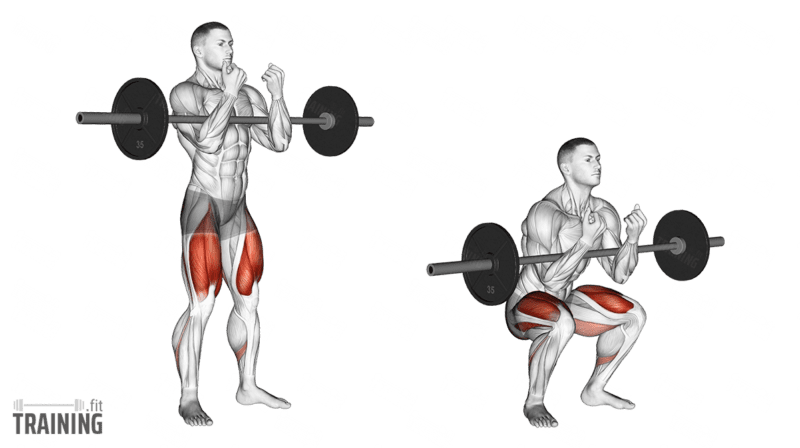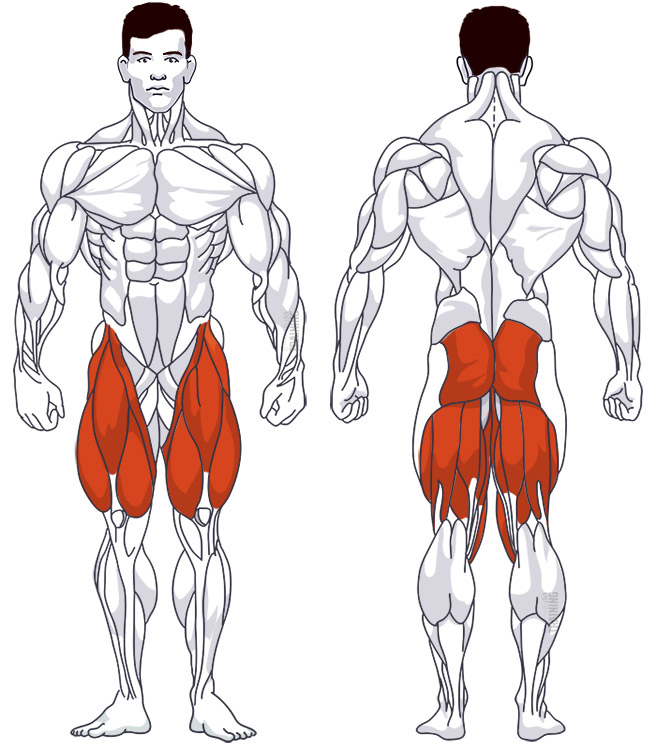Zercher Squat
Compound exercise, Free weightsOverview

Main muscles
- Thigh: Quadriceps
(Musculus quadriceps femoris) - Thigh: Thigh flexor
(Musculus biceps femoris) - Buttocks: Large gluteus maximus
(Musculus gluteus maximus)
Training plans
Here you can find example plans for zercher squat training:
Zercher Squat: Basics and alternatives

Involved main muscle groups:
Zercher Squat
The Zercher Squat is a fantastic compound exercise for your legs and core. Unlike regular barbell squats, the weight isn’t on your neck but rather in the creases of your arms in front of your body. The motion is pretty much the same: you hold the weight in your arm creases, squat down, and stand back up.
A significant benefit of Zercher squats is the relief it offers to your lower back. If you struggle with heavy barbell weights on your neck, give Zercher squats a try as an alternative. However, due to your body posture, the training weight is generally lower, so you’ll need more reps to achieve enough training volume.
Don’t mix up Zercher squats with front squats, where the barbell is also held in front of your body but directly under your neck.
Other options for training your thighs include regular and front squats, dumbbell squats, or the leg press.
Correct execution
It’s best to use a power rack for Zercher squats as well. Adjust the rack height so it’s just below your elbows, making it easy to lift the weight out. Set the safety catches well below this, so you can drop the weight if needed.
Video tutorial
Step-by-step instructions
Stand in front of the barbell. Place it in your arm creases, pressing your elbows tightly against your body and pulling your forearms towards you. Holding your hands together in the middle of your body adds extra stability (see video).
Lift the barbell out of the rack with this arm position. If you’re new to this, try it first without additional weight.
Step away from the rack. Stand with your feet shoulder-width apart, slightly turned out. Keep a slight arch in your lower back, and the rest of your back straight. Tighten your core to maintain proper form. You’re now in the starting position.
Squat down by pushing your butt back and keeping your upper body straight. Your arm position stays the same, keeping the barbell close and stable. Stop once your arms reach your thighs.
Stand back up, pushing the weight up with a slight focus on your heels. Keep your back straight, and the barbell close to your body.
Common mistakes
Zercher squats have a unique advantage and disadvantage: while the weight in your arm creases relieves your lower back, it can also strain your arm creases and forearms. So, avoid using too much weight.
Keep your lower back straight with a slight arch and don’t round your back. When squatting down, keep the weight close to your body, maintaining a straight back. Also, avoid leaning forward, as it can strain your lower back. Make sure to maintain proper form and control throughout the entire movement.
Include Zercher squats in your leg and core training routine for an effective alternative to other squat variations when executed correctly and with proper form.